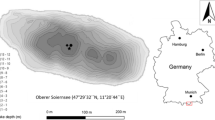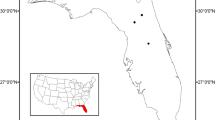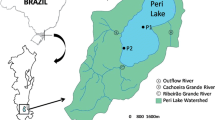Abstract
To reconstruct the historical trend of lake productivity and trophic status in mountain lakes over the past 60 years, we examined the diatom and cladoceran zooplankton remains, fossil pigments, and organic geochemical proxies in a sediment core from Lake Yamanaka, Japan. The fluxes of fossil pigments and total diatom valves, as well as diatom assemblages, did not show any marked changes from the 1960s to the mid-1970s, suggesting that the anthropogenic nutrient input was insufficient for changing the lake trophic status, despite the increased anthropogenic activities around the lake along with the concurrent rapid economic growth in Japan. After the 1990s, the increased fluxes of fossil pigments and percentage of eutrophic diatom species were suggestive of nutrient enrichment in the lake water. After the late 1990s, the stable nitrogen isotope ratios of bulk sediment (δ15Nbulk) gradually decreased with concurrent increases in the total nitrogen (TN) flux, thereby suggesting enhanced atmospheric nutrient deposition. In addition, the reconstructed Chl-a flux considered for post-burial degradation was significantly positively correlated with the summer surface water temperature since 2006. These findings suggest that, in recent decades, not only the anthropogenic nutrient loadings, but also climate warming might have significantly affected the eutrophication in Lake Yamanaka.







Similar content being viewed by others
Data availability
The datasets generated for the purposes of this study are available from the corresponding author upon reasonable request.
References
Appleby, P. G., 2001. Chronostratigraphic techniques in recent sediments. In Last, W. M. & J. P. Smol (eds), Tracking environmental change using lake sediments: developments in paleoenvironmental research, Vol. 1. Springer, Dordrecht: 171–203.
Appleby, P. G. & F. Oldfield, 1978. The calculation of lead-210 dates assuming a constant rate of supply of unsupported 210Pb to the sediment. Catena 5: 1–8.
Ariizumi, K. & K. Yoshizawa, 2002. Water quality of Fuji Five Lakes at the northern foot of Mt. Fuji. Annual Report of the Yamanashi Institute for Public Health 46: 32–41.
Battarbee, R. W. & M. Kneen, 1982. The use of electronically counted microspheres in absolute diatom analysis. Limnology and Oceanography 27: 184–188.
Battarbee, R. W., V. J. Jones, R. J. Flower, N. G. Cameron, H. Bennion, L. Carvalho & S. Juggins, 2002. Diatoms. In Smol, J. P., H. J. B. Birks, W. M. Last, R. S. Bradley & K. Alverson (eds), Tracking environmental change using lake sediments Springer, Dordrecht: 155–202.
Bennion, H., 1994. A diatom-phosphorus transfer function for shallow, eutrophic ponds in southeast England. In Mortensen, E., E. Jeppesen, M. Søndergaard & L. K. Nielsen (eds), Nutrient dynamics and biological structure in shallow freshwater and brackish lakes Springer, Netherlands, Dordrecht: 391–410.
Bigler, C., L. von Gunten, A. F. Lotter, S. Hausmann, A. Blass, C. Ohlendorf & M. Sturm, 2007. Quantifying human-induced eutrophication in Swiss mountain lakes since AD 1800 using diatoms. The Holocene 17: 1141–1154.
Brahney, J., A. P. Ballantyne, P. Kociolek, P. R. Leavitt, G. L. Farmer & J. C. Neff, 2015. Ecological changes in two contrasting lakes associated with human activity and dust transport in western Wyoming. Limnology and Oceanography 60: 678–695.
Carpenter, S. R., N. F. Caraco, D. L. Correll, R. W. Howarth, A. N. Sharpley & V. H. Smith, 1998. Nonpoint pollution of surface waters with phosphorus and nitrogen. Ecological Applications 8: 559–568.
Castañeda, I. S., J. P. Werne, T. C. Johnson & L. A. Powers, 2011. Organic geochemical records from Lake Malawi (East Africa) of the last 700 years, part II: Biomarker evidence for recent changes in primary productivity. Palaeogeography, Palaeoclimatology, Palaeoecology 303: 140–154. https://doi.org/10.1016/j.palaeo.2010.01.006.
Chislock, M. F., E. Doster, R. A. Zitomer & A. E. Wilson, 2013. Eutrophication: Causes, consequences, and controls in aquatic ecosystems. Nature Education Knowledge 4: 10.
Dixit, S. S. & J. P. Smol, 1994. Diatoms as indicators in the environmental monitoring and assessment program-surface waters (EMAP-SW). Environmental Monitoring and Assessment 31: 275–307.
Edlund, M., & J. Kingston, 2004. Expanding a sediment diatom reconstruction model to eutrophic southern Minnesota lakes.
Enache, M. & Y. T. Prairie, 2002. WA-PLS diatom-based pH, TP and DOC inference models from 42 lakes in the Abitibi clay belt area (Québec, Canada). Journal of Paleolimnology 27: 151–171.
Favot, E. J., K. M. Rühland, A. M. DeSellas, R. Ingram, A. M. Paterson & J. P. Smol, 2019. Climate variability promotes unprecedented cyanobacterial blooms in a remote, oligotrophic Ontario lake: Evidence from paleolimnology. Journal of Paleolimnology 62: 31–52.
Fogel, M. L. & L. A. Cifuentes, 1993. Isotope fractionation during primary production. In Engel, M. H. & S. A. Macko (eds), Organic geochemistry: Principles and applications Plenum Press, New York: 73–98.
Frey, D., 1986. Cladocera analysis. In Berglund, B. (ed), Handbook of Holocene palaeoecology and palaeohydrology Wiley, Chichester: 667–692.
Gregory-Eaves, I., J. P. Smol, B. P. Finney & M. E. Edwards, 1999. Diatom-based transfer functions for inferring past climatic and environmental changes in Alaska, USA. Arctic, Antarctic, and Alpine Research 31: 353–365.
Grimm, E. C., 1987. CONISS: A FORTRAN 77 program for stratigraphically constrained cluster analysis by the method of incremental sum of squares. Computers & Geosciences 13: 13–35.
Harradine, P. J., P. G. Harris, R. N. Head, R. P. Harris & J. R. Maxwell, 1996. Steryl chlorin esters are formed by zooplankton herbivory. Geochimica Et Cosmochimica Acta 60: 2256–2270.
Herczeg, A. L., A. K. Smith & J. C. Dighton, 2001. A 120 year record of changes in nitrogen and carbon cycling in Lake Alexandrina, South Australia: C:N, δ15N and δ13C in sediments. Applied Geochemistry 16: 73–84.
Hirabayashi, K., K. Yoshizawa, N. Yoshida & F. Kazama, 2004. Progress of eutrophication and change of chironomid fauna in Lake Yamanakako, Japan. Limnology 5: 47–53.
Hollander, D. J. & J. A. McKenzie, 1991. CO2 control on carbon-isotope fractionation during aqueous photosynthesis: a paleo-pCO2 barometer. Geology 19: 929–932.
Hollander, D. J. & M. Smith, 2001. Microbially mediated carbon cycling as a control on the δ13C of sedimentary carbon in eutrophic Lake Mendota (USA): New models for interpreting isotopic excursions in the sedimentary record. Geochimica Et Cosmochimica Acta 65: 4321–4337.
Hosaka, S., K. Iwashita & T. Ohki, 2009. Correlative analysis for evaluating chlorophyll-a content water body. Journal of the College of Industrial Technology, Nihon University 42: 19–31.
Ishiwatari, R., K. Negishi, H. Yoshikawa & S. Yamamoto, 2009. Glacial-interglacial productivity and environmental changes in Lake Biwa, Japan: a sediment core study of organic carbon, chlorins and biomarkers. Organic Geochemistry 40: 520–530.
King, L. L. & S. G. Wakeham, 1996. Phorbin steryl ester formation by macrozooplankton in the Sargasso Sea. Organic Geochemistry 24: 581–585.
Kusunoki, K. & M. Sakata, 2018. Analysis of historical trend of eutrophication in Lake Nakaumi, Japan, using concentrations of several index elements in sediment cores. Journal of Japan Society on Water Environment 41: 151–157.
Kusunoki, K., M. Sakata, Y. Tani, Y. Seike & K. Ayukawa, 2012. Analysis of historical trend of carotenoid concentrations in sediment cores from Lake Shinji, Japan. Geochemical Journal 46: 225–233.
Kuwae, M., S. Yoshikawa, N. Tsugeki & Y. Inouchi, 2004. Reconstruction of a climate record for the past 140 kyr based on diatom valve flux data from Lake Biwa, Japan. Journal of Paleolimnology 32: 19–39.
Kuwae, M., K. N. Tsugeki, B. P. Finney, Y. Tani, J. Onodera, M. Kiyoto, M. Kusaka, T. Sagawa, Y. Nakamura, H. Ohnishi, H. Kuroda, N. Okuda, T. Ohta, M. Ikehara & T. Irino, 2022. Late Holocene centennial to millennial-scale variability in lower trophic level productivity off southern Hokkaido, Japan and its response to dissolved iron-replete Coastal Oyashio dynamics. Quaternary Research 107: 27–42.
Lamair, L., A. Hubert-Ferrari, M. El Ouahabi, S. Yamamoto, S. Schmidt, J. Vander Auwera, G. Lepoint, E. Boes, O. Fujiwara, Y. Yokoyama, M. De Batist & V. M. A. Heyvaert, 2019. Late Holocene changes in erosion patterns in a lacustrine environment: landscape stabilization by volcanic activity versus human activity. Geochemistry, Geophysics, Geosystems 20: 1720–1733.
Leavitt, P. R. & S. R. Carpenter, 1990. Aphotic pigment degradation in the hypolimnion: Implications for sedimentation studies and paleolimnology. Limnology and Oceanography 35: 520–534.
Leavitt, P. R., C. S. Brock, C. Ebel & A. Patoine, 2006. Landscape-scale effects of urban nitrogen on a chain of freshwater lakes in central North America. Limnology and Oceanography 51: 2262–2277.
Legendre, L. & P. Legendre, 1983. Numerical ecology: Developments in environmental modelling, Elsevier, Amsterdam:
Lehmann, M., S. M. Bernasconi, A. Barbieri, J. A. McKenzie, L. S. Ambientali, R. Pradiso, M. Lehmann, S. M. Bernasconi, A. Barbieri & J. A. McKenzie, 2002. Preservation of organic matter and alteration of its carbon and nitrogen isotope composition during simulated and in situ early sedimentary diagenesis. Geochimica Et Cosmochimica Acta 66: 3573–3584.
Louda, J. W., J. W. Loitz, D. T. Rudnick & E. W. Baker, 2000. Early diagenetic alteration of chlorophyll-a and bacteriochlorophyll-a in a contemporaneous marl ecosystem; Florida Bay. Organic Geochemistry 31: 1561–1580.
Meyers, P. A., 1994. Preservation of elemental and isotopic source identification of sedimentary organic matter. Chemical Geology 144: 289–302.
Meyers, P. A., 2003. Applications of organic geochemistry to paleolimnological reconstructions: a summary of examples from the Laurentian Great Lakes. Organic Geochemistry 34: 2611–3289.
Ming-Yi, S., C. Lee & R. C. Aller, 1993. Laboratory studies of oxic and anoxic degradation of chlorophyll-a in Long Island Sound sediments. Geochimica Et Cosmochimica Acta 57: 147–157.
Miyashita, Y. & H. Mimura, 2004. Results of research on nitrogen source in the watersheds of Lake Sagami and Lake Tsukui. Bulletin of the Hot Spring Research Institute of Kanagawa Prefecture 36: 1–24.
Montagnes, D. J. S. & D. J. Franklin, 2001. Effect of temperature on diatom volume, growth rate, and carbon and nitrogen content: Reconsidering some paradigms. Limnology and Oceanography 46: 2008–2018.
Naeher, S., H. Suga, N. O. Ogawa, Y. Takano, C. J. Schubert, K. Grice & N. Ohkouchi, 2016. Distributions and compound-specific isotopic signatures of sedimentary chlorins reflect the composition of photoautotrophic communities and their carbon and nitrogen sources in Swiss lakes and the Black Sea. Chemical Geology 443: 198–209. https://doi.org/10.1016/j.chemgeo.2016.04.029.
Nara, F., Y. Tani, Y. Soma, M. Soma, H. Naraoka, T. Watanabe, K. Horiuchi, T. Kawai, T. Oda & T. Nakamura, 2005. Response of phytoplankton productivity to climate change recorded by sedimentary photosynthetic pigments in Lake Hovsgol (Mongolia) for the last 23,000 years. Quaternary International 136: 71–81.
Ogawa, N. O., T. Koitabashi, H. Oda, T. Nakamura, N. Ohkouchi & E. Wada, 2001. Fluctuations of nitrogen isotope ratio of gobiid fish (Isaza) specimens and sediments in Lake Biwa, Japan, during the 20th century. Limnology and Oceanography 46: 1228–1236.
Philibert, A. & Y. T. Prairie, 2002. Diatom-based transfer functions for western Quebec lakes (Abitibi and Haute Mauricie): the possible role of epilimnetic CO2 concentration in influencing diatom assemblages. Journal of Paleolimnology 27: 465–480.
Ponader, K. C., D. F. Charles & T. J. Belton, 2007. Diatom-based TP and TN inference models and indices for monitoring nutrient enrichment of New Jersey streams. Ecological Indicators 7: 79–93.
Ryding, S. O. & W. Rast, 1989. The control of eutrophication of lakes and reservoirs, UNESCO and Parthenon Publishers, Paris:
Saijyo, Y., 1950. Limnology of the five lakes at the foot of Mt. Fuji (5) physical and chemical studies of lake Yamanaka. Geographical Review of Japan 22: 357–360.
Schelske, C. L. & D. A. Hodell, 1995. Using carbon isotopes of bulk sedimentary organic matter to reconstruct the history of nutrient loading and eutrophication in Lake Erie. Limnology and Oceanography 40: 918–929.
Soma, Y., Y. Tani, M. Soma, H. Mitake, R. Kurihara, S. Hashomoto, T. Watanabe & T. Nakamura, 2007. Sedimentary Steryl Chlorin Esters (SCEs) and other photosynthetic pigments as indicators of paleolimnological change over the last 28,000 years from the Buguldeika Saddle of Lake Baikal. Journal of Paleolimnology 37: 163–175.
Squier, A. H., D. A. Hodgson & B. J. Keely, 2002. Sedimentary pigments as markers for environmental change in an Antarctic lake. Organic Geochemistry 33: 1655–1665.
Talbot, M. R., 2005. Nitrogen isotopes in palaeolimnology tracking environmental change using lake sediments: Physical and chemical techniques, Kluwer, Dordrecht:, 401–439.
Talbot, H. M., R. N. Head, R. P. Harris & J. R. Maxwell, 1999a. Steryl esters of pyropheophorbide: a sedimentary sink for chlorophyll b. Organic Geochemistry 30: 1403–1410.
Talbot, H. M., R. N. Head, R. P. Harris & J. R. Maxwell, 1999b. Distribution and stability of steryl chlorin esters in copepod faecal pellets from diatom grazing. Organic Geochemistry 30: 1163–1174.
Tani, Y., G. I. Matsumoto, M. Soma, Y. Soma, S. Hashimoto & T. Kawai, 2009a. Photosynthetic pigments in sediment core HDP-04 from Lake Hovsgol, Mongolia, and their implication for changes in algal productivity and lake environment for the last 1 Ma. Quaternary International 205: 74–83.
Tani, Y., F. Nara, Y. Soma, M. Soma, N. Itoh, G. I. Matsumoto, A. Tanaka & T. Kawai, 2009b. Phytoplankton assemblage in the Plio-Pleistocene record of Lake Baikal as indicated by sedimentary steryl chlorin esters. Quaternary International 205: 126–136.
Taucher, J. & A. Oschlies, 2011. Can we predict the direction of marine primary production change under global warming? Geophysical Research Letters 38: L02603.
Teranes, J. L. & S. M. Bernasconi, 2000. The record of nitrate utilization and productivity limitation provided by δ15N values in lake organic matter - A study of sediment trap and core sediments from Baldeggersee, Switzerland. Limnology and Oceanography 45: 801–813.
Tsugeki, N., H. Oda & J. Urabe, 2003. Fluctuation of the zooplankton community in Lake Biwa during the 20th century: a paleolimnological analysis. Limnology 4: 101–107.
Tsugeki, N. K., S. Ishida & J. Urabe, 2009. Sedimentary records of reduction in resting egg production of Daphnia galeata in Lake Biwa during the 20th century: a possible effect of winter warming. Journal of Paleolimnology 42: 155–165.
Tsugeki, N. K., J. Urabe, Y. Hayami, M. Kuwae & M. Nakanishi, 2010. Phytoplankton dynamics in Lake Biwa during the 20th century: complex responses to climate variations and changes in nutrient status. Journal of Paleolimnology 44: 69–83.
Tsugeki, N. K., T. Agusa, S. Ueda, M. Kuwae, H. Oda, S. Tanabe, Y. Tani, K. Toyoda, W. Wang & J. Urabe, 2012. Eutrophication of mountain lakes in Japan due to increasing deposition of anthropogenically produced dust. Ecological Research 27: 1041–1052.
Tsugeki, N. K., M. Kuwae, Y. Tani, X. Guo, K. Omori & H. Takeoka, 2017. Temporal variations in phytoplankton biomass over the past 150 years in the western Seto Inland Sea. Journal of Oceanography 73: 309–320.
Tsugeki, N. K., M. N. Honjyo & M. Kuwae, 2021. Interspecific variation in ephippial size between Daphnia galeata and D. pulicaria in Lake Biwa, Japan. Limnology 22: 197–207.
Umezawa, Y., T. Hosono, S. Onodera, F. Siringand, S. Buapeng, R. Delinom, C. Yoshimizu, I. Tayasu, T. Nagata & M. Taniguchi, 2009. Tracing the sources of nitrate and ammonium concentrations in groundwater at develo** Asian megacities, using GIS data and nitrate δ15N and δ18O. Science of the Total Environment 407: 3219–3231.
Watanabe, E., 2015. Changing characteristics of Hoyo-jo in Yamanakako Village, Yamanashi Prefecture. Journal of Geography (Chigaku Zasshi) 124: 979–993.
Wolfe, A., J. S. Baraon, & R. Cornett, 2001. Anthropogenic nitrogen deposition induces rapid ecological changes in alpine lakes of the Colorado Front Range (USA). Journal of Paleolimnology 25: 1–7.
Woolway, R. I., B. M. Kraemer, J. D. Lenters, C. J. Merchant, C. M. O’Reilly & S. Sharma, 2020. Global lake responses to climate change. Nature Reviews Earth and Environment 1: 388–403.
Yamamoto, S., A. Hubert-ferrari, L. Lamair, Y. Miyata, S. Ochiai, S. Nagao, N. Miyauchi, K. Yoshida, O. Fujiwara, Y. Yokoyama, V. M. A. Heyvaert, M. De Batist, The QuakeRecNankai Team, 2020. Organic carbon accumulation and productivity over the past 130 years in Lake Kawaguchi (central Japan) reconstructed using organic geochemical proxies. Journal of Paleolimnology 64: 365–377.
Yamamoto, S., T. Nakamura, S. Lee & M. Yasuhara, 2022. Origin of a temporary pond, Akaike, at the northern foot of Mount Fuji, Japan, July 2020. Journal of Geography (Chigaku Zasshi) 131: 83–93.
Yamanashi Prefecture, 2018. The statistical yearbook of Yamanashi Prefecture, Yamanashi Prefecture, Kofu.
Yamanashi Prefecture, 1993. The water quality of the Fuji Five Lakes over 21 years (in Japanese), Yamanashi Prefecture, Kofu.
Yamanashi Prefecture, 2022. The results of water quality measurements in areas of public water. http://www.pref.yamanashi.jp/taiki-sui/sokutei.html
Acknowledgements
We acknowledge the Yamanashi Prefectural Air Quality Protection Division and the Yamanashi Institute of Public Health and Environment for providing the results of chlorophyll a concentration measurements from Lake Yamanaka. We also thank two anonymous reviewers for their constructive comments, which helped to improve the manuscript.
Funding
This study was supported by the Ministry of Education, Culture, Sports, Science and Technology, Japan (MEXT), through a project on Joint Usage/Research Center–Leading Academia in Marine and Environment Pollution Research (LaMer).
Author information
Authors and Affiliations
Contributions
All authors contributed to the study conception and design, as well as data collection and analysis. The first draft of the manuscript was written by SY and NT with substantial contribution from all authors. All authors read and approved the final manuscript.
Corresponding author
Ethics declarations
Conflict of interest
The authors declare that they have no competing interests.
Additional information
Handling editor: Jasmine Saros
Publisher's Note
Springer Nature remains neutral with regard to jurisdictional claims in published maps and institutional affiliations.
Rights and permissions
Springer Nature or its licensor (e.g. a society or other partner) holds exclusive rights to this article under a publishing agreement with the author(s) or other rightsholder(s); author self-archiving of the accepted manuscript version of this article is solely governed by the terms of such publishing agreement and applicable law.
About this article
Cite this article
Yamamoto, S., Kuwae, M., Tsugeki, N. et al. Implication of atmospheric nutrient inputs and warming effects for the ecosystem of Lake Yamanaka, Japan, revealed by sedimentary analysis. Hydrobiologia 850, 1487–1501 (2023). https://doi.org/10.1007/s10750-022-05071-9
Received:
Revised:
Accepted:
Published:
Issue Date:
DOI: https://doi.org/10.1007/s10750-022-05071-9




